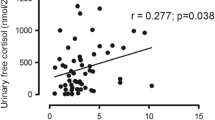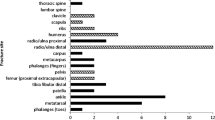Abstract
Bone mineral density (BMD) was measured by dual-energy X-ray absorptiometry (DEXA) in 133 normal females on five regions of the femoral site: neck, trochanteric, intertrochanteric, Ward’s triangle, and total area of the proximal femur. One hundred and twenty-five women (56 older than 65, range 65–97, and 69 with an age range of 21–65) were also examined for spinal bone mineral density. The mean in vivo precision (CV%) of the measurements with respositioning assessed on five young and eight elderly patients was ranged from 0.7% to 1.7% but lowerfor Ward’s triangle (CV=2.95% and 3.87%). Between 30 and 90 years, a linear age-related bone mineral decrease was found at all sites with a similar magnitude of bone loss for the femoral neck, total or intertrochanteric regions (−33% to −39%). A greater decrease was found for the Ward’s triangle region (−61 %). In the subgroup of elderly women (65–97 years old), the lumbar BMD measured with an anteroposterior incidence did not decrease significantly with age, contrasting with an average 27% decrease of the BMD of the hip between 65 and 90 years of age.
In addition, 31 patients suffering either from a cervical (n=12) or pertrochanteric (n=19) fracture were measured on their contralateral. femur 15 to 30 days after the fracture event. The mean calculated BMD values were, depending on the measured area, from 14% to 21% lower than those reported for age-matched controls (z-score from −1.11 to −0.65). A fracture threshold was determined for each site from this population and the elderly controls. The best discrimination between patients and controls was obtained at the femoral neck site, with a value of 0.57 g/cm2 providing a specificity of 69% with a sensitivity of 75%.
In conclusion, bone mineral content of the proximal femur can be measured with an acceptable precision by dual-energy X-ray absorptiometry. In elderly people, this site appears more suitable than the lumbar spine for the detection of age-related bone loss. Bone mineral density appears to be one major determinant in the causation of hip fracture.
Similar content being viewed by others
References
Melton LJ III. Epidemiology of fractures. In: Riggs BL, Melton LJ III, eds. Osteoporosis: etiology, diagnosis and management. New York: Raven Press, 1988; 133–54.
Melton LJ III, Wahner HW, Richelson LS. Osteoporosis and the risks of fracture. Am J Epidemiol 1986; 124:254–61.
Gallagher JC, Melton LJ III, Riggs BL, Bergstrath E. Epidemiology of fractures of the proximal femur in Rochester, Minnesota. Clin Orthop 1980; 150:163–71.
Ross, PD, Wasnich RD. Vogel JM. Detection of prefracture spinal osteoporosis using bone mineral absortiometry. J Bone Miner Res 1988; 3:1–11.
Hansson T, Roos B. Age change in the bone mineral of the lumbar spine in normal women. Calcif Tissue tnt 1986; 38:249–51.
Braillon P, Duboeuf F, Meary MF, Barret P, Delmas PD, Meunier PJ. Mesure du contenu minéral osseux par radiographic digitale quantitative: Premiers résultats au niveau lombaire. Presse Med 1989; 18:1062–5.
Kelly TL, Slovik DM, Schoenfeld DA, Neer RM. Quantitative digital radiography versus dual-photon absorptiometry of the lumbar spine. J Clin Endocrinol Metab 1988; 67:839–44.
Sartoris DJ, Resnick D. Current and innovative methods for non-invasive bone densitometry. Orthopedics 1990; 28:257–78.
Pouilles JM, Bernard J, Tremolliére F, Louvet JP, Ribot C. Femoral bone density in young male adults with stress fracture. Bone 1989; 10:105–8.
Mazess RB, Wahner MW. Nuclear medicine and densitometry. In: Riggs LB, Melton LJ, III, eds. Osteoporosis; etiology, diagnosis and management. New York: Raven Press 1988:145
Wahner HW. Non-invasive measurement of bone loss in the femoral neck. In: Kleerekoper M, Krane SM, eds. Clinical disorders of bone and mineral metabolism. New York: Liebert 1989: 237–46.
McClung MR. Roberts IA. Comparison of precision performance with dual-energy X-ray absorptimetry. Seventh International Workshop on bone densitometry, Rancho Mirage, California, 1989; 140 (abstract).
Gluer CC, Steiger P, Selvidge R, Elliesen-Kliefoth K, Hayashi C, Genant HK. Comparative assessment of dual-photon absorptiometry and dual-energy radiography. Radiology 1990; 174:223–8.
Borders J, Kerr E, Sartoris DJ. Quantitative dual-energy radiographic absorptiometry of the lumbar spine: In vivo comparison with dual-photon absorptiometry. Radiology 1989; 170:129–31.
Slosman DO, Rizzoli R, Buchs B, Piana F, Donath A, Bonjour JP, Comparative study of the performance of X-ray and gadolinium 153 bone densitometers at the level of the spine, femoral neck and femoral shaft. Eur J Nucl Med 1990; 17:3–9.
Riggs BL, Wahner HW, Seeman E. et al. Changes in bone mineral density of the proximal femur and spine with aging: Differences between the postmenopausal and senile osteoporosis syndrome. J Clin Invest 1982; 70:716–23.
Schaadt O, Bohr H. Different trends of age-related diminution of bone mineral content in the lumbar spine, femoral neck, and femoral shaft in women. Calcif Tissue tnt 1988; 42:71–6.
Pocock NA, Eisman JA, Mazess RB, Sambrook PN, Yeates MG, Freund J. Bone mineral density in Australia compared to the United States. J Bone Miner Res 1988; 3:601–4.
Sartoris JD, Sommer FG, Marcus R, Madvig P. Bone mineral density in the femoral neck: quantitative assessment using dual-energy projection radiography. AJR 1985; 144:605–11.
Hedlund LR, Gallagher JC. The effect of age and menopause on bone mineral density of the proximal femur. J Bone Miner Res 1989; 4:639–42.
Norimatsu H, Mori S, Uesato T, Yoshikawa T, Katsuyama N. Bone mineral density of the spine and proximal femur in normal and osteoporotic subjects in Japan. Bone Miner 1989; 5:213–21.
Uebelhart D, Duboeuf F, Meunier PJ, Delmas PD. Lateral dual-photon absorptiometry: a new technique to measure the cancel-lous bone mineral density of the lumbar spine. J Bone Miner Res 1990; 5:525–30.
Cummings SR, Black DM, Nevitt MC, Browner WS. Appendicular bone density and age predict hip fracture in women. JAMA 1990; 263:665–8.
Mazess RB, Peppler WW, Chesney RW, Lang TA, Lindgren U, Smith E. Does bone measurement on the radius indicate skeletal status? J Nucl Med 1984; 25:281–8.
Barden WS, Mazess RB. Bone densitometry of the appendicular and axial skeleton. Top Geriatr Rehabil 1989; 4:1–12.
Eastell R, Wahner HW, O’Fallen WM, Amadio PC, Melton LJ III, Riggs BL. Unequal decrease in bone density of lumbar spine and ultradistal radius in Colles’ and vertebral fracture syndromes. J Clin Invest 1989; 83:168–74.
Mazess RB, Barden H, Ettinger M, Schultz E. Bone density of the radius, spine, and proximal femur in osteoporosis. J Bone Miner Res 1988; 3:13–18
Wasnich RD, Ross PD, Davis JW, Vogel JM. A comparison of single and multi-site BMC measurements for assessment of spine fracture probability. J Nucl Med 1989; 30:1166–71
Nilas L, Podenphant J, Riis JR, Gotfredsen A, Christiansen C. Usefulness of regional bone measurements in patients with osteoporotic fractures of the spine and distal forearm, J. Nucl Med 1987; 28:960–65.
Need AG, Nordin BEC. Which bone to measure? Osteoporosis Int 1990; 1:3–6.
Cummings SR, Nevitt MC. A hypothesis: the causes of hip fractures. J Gerontol 1989; 44:M107–11.
Author information
Authors and Affiliations
Rights and permissions
About this article
Cite this article
Duboeuf, F., Braillon, P., Chapuy, M.C. et al. Bone mineral density of the hip measured with dual-energy X-ray absorptiometry in normal elderly women and in patients with hip fracture. Osteoporosis Int 1, 242–249 (1991). https://doi.org/10.1007/BF03187468
Received:
Accepted:
Issue Date:
DOI: https://doi.org/10.1007/BF03187468




